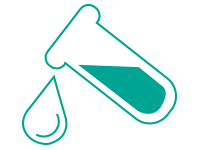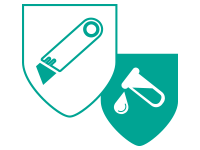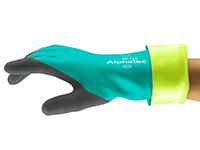
A variety of hazards can endanger worker safety in industrial environments.
This is exacerbated when multiple risk factors are present such as exposure to chemical substances or other liquids, are combined with cut risk.
Until now, safety managers have employed a 'one-glove-fits-all-applications' mentality. This approach has led to compromise in vital areas such as comfort, dexterity, and grip. Fortunately, continual advances in technology are delivering material improvements that assist in development of superior specialist hand protection solutions.This makes the need to choose between one hazard protection or another, obsolete. The provision of unsuitable personal protective equipment (PPE) can have a serious detrimental impact on productivity and profitability. This is because workers are encouraged to wear separate cut and chemical protective gloves, rather than wearing the same set of gloves for different types of exposure at the same time.

PPE Legislation Is Not Open To Interpretation
PPE legislation places responsibility to provide for a safe workplace, with suitable safety equipment on the employer. It’s crucial to look at all available solutions to determine suitability for specific workplace conditions.
Safety managers are required to conduct a thorough workplace risk assessment to deal with multiple, varied risks. When exposure to risk cannot be practically avoided, PPE must be used. Employers are obliged to evaluate the risks, weigh options, and select safety solutions that not only adheres to applicable laws and standards, but is also of good quality and best suited to the task. Safety legislation dictates that the assessment process and reasons for selection of the chosen PPE be recorded. Workers must be made aware of present risks and supplied with appropriate and correctly fitted equipment. They also need to be provided with written rules when PPE utilisation is compulsory, and adequate instruction on the proper use of the PPE.
In the context of multiple exposures, safety managers should opt for a solution that best defends workers against all present hazards, not just the primary hazard alone.

Making the Cut
When selecting the right PPE, the types of jobs, and the associated risks, will determine the most appropriate glove choice. Specialised cut resistant gloves are made using a cut resistant yarn that has been tested to perform to — or exceed — industry standards, offering best-in-class cut resistance with no loss of dexterity or movement. The wrong hand protection solution can cause injury due to a lack of adequate grip or loss of dexterity. This makes workers struggle to handle the tools or machinery required to carry out tasks.
This is exacerbated in the case of applications where liquids are present, such as the petrochemical industry. Or when working with hydrocarbon derivatives, polymer derivatives, alcohol bases and esters.

Reaction Against Chemicals
Chemical resistant gloves come in a wide variety of barrier materials, thicknesses, and designs. While each barrier material will protect against a range of chemical groups, they may also be less effective against some chemical groups or mixes. There isn’t one solution for all applications. You need to carefully identify the best alternative for the unique range of chemicals and liquids in your situation.
The chosen PPE may also need to integrate additional high-performance features, including an advanced grip and moisture management technology to ensure worker comfort.

Combining Cut and Chemical Resistance
Before modern advancements in material science, safety practices increased risk. Workers used to ‘double-glove’ in situations where there were both cut and liquid/chemical risk. This practice affected dexterity, which can lead to the negation of one (or both) hand protection solutions. However, thanks to advances in material and construction technology, solutions are now available to provide superior protection against both hazards in one design.
When selecting suitable defence against cut and chemical risk, safety managers should look for a glove that features a suitable barrier against liquids and chemicals. A glove that offers an enhanced oil grip will reduce fatigue and injury by offering increased control while minimising the force needed to safely handle equipment. Selecting a glove that incorporates high cut and puncture resistance is crucial. It is designed to withstand exposure to dynamic industrial working environments.
Also consider using PPE that’s made from high-visibility fabric. This ensures workers are both seen and safe in low light environments.

One example that offers high levels of cut and chemical resistance is the AlphaTec® 58-735. Its nitrile shell barrier offers EN 374 Type A resistance against common chemicals. INTERCEPT™ Cut Resistance Technology provides a high-level of cut resistance. For increased safety measure, it’s lined with a high-visibility fabric that indicates when the glove is cut and compromised.